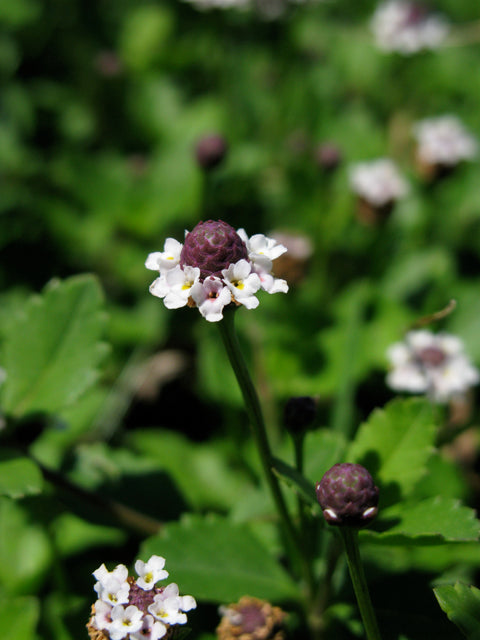Frogfruit (Phyla nodiflora var. incisa)
Frogfruit (Phyla nodiflora var. incisa)
21 in stock
Couldn't load pickup availability
Phyla nodiflora
Phyla nodiflora (L.) Greene
Texas Frogfruit, Turkey Tangle Fogfruit, Frogfruit
Verbenaceae (Verbena Family)
Synonym(s): Lippia incisa, Lippia nodiflora, Lippia nodiflora var. reptans, Lippia reptans, Phyla incisa, Phyla nodiflora var. incisa, Phyla nodiflora var. longifolia, Phyla nodiflora var. nodiflora, Phyla nodiflora var. repens, Phyla nodiflora var. reptans, Phyla nodiflora var. rosea
USDA Symbol: phno2
USDA Native Status: L48 (N), HI (I), PR (N), VI (N)
Texas Frogfruit can be used as an excellent ground cover and is evergreen in warm years. It is also evergreen in areas protected from frost. It spreads vigorously. Frogfruit generally is a good nectar plant for butterflies. It is an attractive plant rambling over boulders or the edges of hanging baskets. It also can tolerate drought and flooding.
This species is a member of the verbena family (family Verbenaceae), which includes about 75 genera and 3,000 species of herbs, shrubs, and trees, mostly of tropical and warm temperate regions. Among them, teak is a highly prized furniture wood, and Vervain, Lantana, Lippia or Frog Fruit, and Chase Tree or Vitex are grown as ornamentals.
Plant Characteristics
Duration: Perennial
Habit: Herb
Leaf Retention: Semi-evergreen
Fruit Type: Schizocarp
Size Notes: Up to about 6 inches tall.
Leaf: Green, with reddish or purplish tinge in cold winters.
Fruit: Separates into 2 nutlets.
Bloom Information
Bloom Color: White , Red , PinkBloom Time: May , Jun , Jul , Aug , Sep , Oct , Nov
Bloom Notes: White to pink or reddish.
Distribution
USA: AL , AR , AZ , CA , FL , GA , HI , KS , KY , LA , MD , MO , MS , NC , NM , NV , OK , OR , PA , SC , TX , UT , VANative Distribution: Southern half of the US to the tropics.
Native Habitat: Anywhere from ditches and roadways to beaches and fields.
Growing Conditions
Water Use: Low , MediumLight Requirement: Sun , Part Shade
Soil Moisture: Dry , Moist
CaCO3 Tolerance: Medium
Heat Tolerant: yes
Soil Description: Sand, loam, clay, caliche, limestone. Poor drainage and saline soils okay.
Conditions Comments: Tolerates drought and flooding. Will go dormant during hard winters.
Benefit
Use Ornamental: A great groundcover for full sun and part shade areas, with trailing foliage and charming, mini-verbena-like flowers. Would also do well as a pot plant.Use Wildlife: Attracts numerous insect pollinators.
Conspicuous Flowers: yes
Attracts: Butterflies
Larval Host: Phaon Crescentspot, Buckeye, and White Peacock butterflies
Nectar Source: yes
Deer Resistant: Moderate
Propagation
Propagation Material: Root DivisionCommercially Avail: yes
Maintenance: Water in dry areas or seasons to maintain a solid cover. Do not mow while blooming, as it can take years to recover.
https://www.wildflower.org/plants/result.php?id_plant=CHME3
Image Information
Photographer: Muller, Thomas L.City: Avon
County: Dare
State: NC
Location Notes: Cape Hatteras National Seashore
Accession date: 2010-10-26
Filename: TLM_IMG00390.JPG
Slide Index: TLM_IMG_3760.JPG
Restrictions: Unrestricted
Collection: Wildflower Center Digital Library
Original Format: digital
Orientation: Portrait
Shot: Flower.
Date Taken: 2010-09-09
NPIN Image Id: 28394


